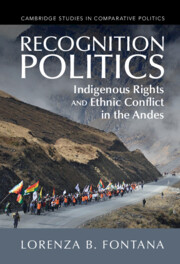Book contents
- Recognition Politics
- Cambridge Studies in Comparative Politics
- Recognition Politics
- Copyright page
- Dedication
- Contents
- Figures
- Tables
- Acknowledgements
- Acronyms and Abbreviations
- Introduction
- 1 Recognition Conflicts
- 2 Citizenship and Development in the Andes
- 3 Class and Ethnic Shifts
- 4 Recognition for Whom?
- 5 The Physical Boundaries of Identity
- 6 Unsettled Demographies
- 7 Struggles for Inclusion and Exclusion
- 8 Rethinking Recognition: What Are the Implications for Identity Governance?
- References
- Index
- Other Books in the Series (continued from page ii)
6 - Unsettled Demographies
Published online by Cambridge University Press: 05 January 2023
- Recognition Politics
- Cambridge Studies in Comparative Politics
- Recognition Politics
- Copyright page
- Dedication
- Contents
- Figures
- Tables
- Acknowledgements
- Acronyms and Abbreviations
- Introduction
- 1 Recognition Conflicts
- 2 Citizenship and Development in the Andes
- 3 Class and Ethnic Shifts
- 4 Recognition for Whom?
- 5 The Physical Boundaries of Identity
- 6 Unsettled Demographies
- 7 Struggles for Inclusion and Exclusion
- 8 Rethinking Recognition: What Are the Implications for Identity Governance?
- References
- Index
- Other Books in the Series (continued from page ii)
Summary
Changes in local demographics have introduced new challenges for the coexistence of different social groups in the post-recognition phase. These changes are rooted in both exogenous and endogenous factors. On one hand, sustained migration has created new settlements, expanded the agrarian frontier, and pushed indigenous groups to assume a more hostile and protectionist attitude towards non-indigenous settlers. On the other, indigenous groups’ increasing population rates have encouraged an expansionist strategy that involves targeting new territories already occupied by other groups. This chapter considers both exogenously and endogenously driven changes in rural demographics as factors that contribute to the new relevance of social heterogeneity and of distributive measures embedded in recognition reforms. As I illustrated in the previous chapter, land is often at the root of recognition disputes in the context of resource scarcity. In this chapter, I analyse how changes in social heterogeneity can fuel land conflicts as well as conflicts for social provisions (e.g. access to water and electricity), linked to the implementation of recognition reforms. As in the previous chapter, norms around land tenure work as ‘means of redistribution’ embedded in a recognition framework that dramatically influences communities’ access to key resources and is often an object of contention. I discuss these tensions in relation to shifts and shocks in social communities’ demographic composition which result in increased social heterogeneity. Because these conflicts are all related to changes in local demographics, I call this type of recognition conflict demographic conflict. I rely on empirical cases from the inter-Andean regions of Peru to illustrate the challenging coexistence of rural migrants and indigenous communities; and on the case of the Cauca Department in Colombia to analyse how population growth, combined with a situation of widespread and acute violence generated by the civil war, has aggravated resource competition. Based on these empirical cases, I argue that the recognition framework is poorly equipped to account for the more fluid aspects of social communities embedded in migration dynamics and other demographic changes.
Keywords
- Type
- Chapter
- Information
- Recognition PoliticsIndigenous Rights and Ethnic Conflict in the Andes, pp. 152 - 174Publisher: Cambridge University PressPrint publication year: 2023

